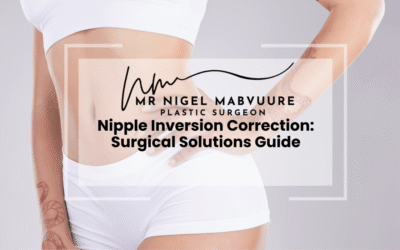Breast Asymmetry Correction with Implants
- Breast asymmetry is a common condition affecting up to 88% of women, with multiple correction options available through surgical intervention.
- Precise implant selection requires detailed measurements, considering factors like breast base width, tissue characteristics, and desired aesthetic outcome.
- Surgical correction can involve different implant sizes, profiles, and placement techniques to achieve optimal symmetry and natural results.
- Recovery typically spans 4-6 weeks, with patients able to return to light activities within 1-2 weeks post-surgery.
- Modern implant technologies and advanced surgical techniques provide long-lasting, high-satisfaction results for breast asymmetry correction.
- Combined procedures like breast lift or nipple repositioning may be recommended for comprehensive asymmetry correction.
- Regular follow-up and monitoring are crucial for maintaining long-term breast symmetry and implant health.
Table of Contents
- Understanding Breast Asymmetry – Types, Causes and Impact
- How Can Breast Implants Correct Uneven Breasts?
- Choosing the Right Implant Sizes for Asymmetrical Breasts
- Over vs Under the Muscle – Best Placement for Asymmetry
- The Surgical Process – What to Expect During Your Procedure
- Recovery Timeline and Post-Surgery Care Guidelines
- Combining Breast Augmentation with Other Procedures
- Long-Term Results and Maintaining Breast Symmetry
Understanding Breast Asymmetry – Types, Causes and Impact
Breast asymmetry is a common condition affecting up to 88% of women, though the degree of asymmetry varies significantly. This natural variation can manifest in different ways, including size discrepancies, position differences, and variations in breast shape or nipple placement. The condition may be congenital, develop during puberty, or occur due to hormonal changes, pregnancy, or weight fluctuations.
Medical professionals classify breast asymmetry into three primary categories: volume asymmetry (size differences), shape asymmetry (including tuberous breast deformity), and position asymmetry (where breasts sit at different heights on the chest wall). Understanding these distinctions is crucial for determining the most appropriate surgical approach for correction.
How Can Breast Implants Correct Uneven Breasts?
Breast augmentation for asymmetry offers a highly effective solution for creating balanced, natural-looking results. The procedure typically involves using different sized implants to achieve symmetry, with careful consideration given to both breast volume and dimensions. Modern implant options, including the premium Mentor range, provide surgeons with precise tools to address specific asymmetry concerns.
The correction process may involve using implants of different sizes, profiles, or projections to achieve optimal balance. For instance, a 375cc implant might be used in the smaller breast while a 325cc implant is placed in the larger one, allowing for customised correction of volume differences while maintaining a natural appearance.
Understanding Breast Asymmetry: Causes, Concerns, and Surgical Solutions
Choosing the Right Implant Sizes for Asymmetrical Breasts
Selecting appropriate implant sizes requires careful measurement and planning. Your surgeon will take detailed measurements of your breast dimensions, including base width, height, and projection. These measurements, combined with 3D imaging technology, help determine the optimal implant sizes needed to achieve symmetry.
The selection process considers not only volume differences but also factors such as tissue characteristics, chest wall anatomy, and desired final outcome. For example, if one breast has a wider base, a different implant profile might be chosen to match the narrower breast, ensuring harmonious results.
Over vs Under the Muscle – Best Placement for Asymmetry
The decision between over-the-muscle (subglandular) and under-the-muscle (submuscular) placement is particularly crucial in asymmetry correction. Submuscular placement often provides better coverage and more natural-looking results, especially in patients with minimal breast tissue. However, the choice depends on individual factors including tissue thickness, degree of asymmetry, and lifestyle considerations.
For significant asymmetry cases, dual-plane placement might be recommended, where the implant is partially covered by the muscle. This technique can provide optimal shape while maintaining natural movement and feel.
The Surgical Process – What to Expect During Your Procedure
The surgical process begins with precise pre-operative marking and planning. Under general anaesthesia, your surgeon will create carefully positioned incisions, typically in the inframammary fold. The procedure usually takes 1-2 hours, during which different-sized implant pockets are created to accommodate the selected implants.
Advanced surgical techniques, including precise pocket dissection and careful implant positioning, ensure optimal symmetry. The surgeon may also address any additional anatomical variations, such as differences in breast fold position or nipple placement, during the same procedure.
Recovery Timeline and Post-Surgery Care Guidelines
Recovery following asymmetry correction typically spans 4-6 weeks. Initial swelling may temporarily mask the final results, but patients can usually return to light activities within 1-2 weeks. A specialised post-operative support bra helps maintain implant position and promote proper healing.
Follow-up appointments are scheduled at key recovery milestones to monitor healing and ensure optimal results. Patients receive detailed aftercare instructions, including exercises to promote proper implant settling and maintain long-term symmetry.
Combining Breast Augmentation with Other Procedures
In cases of complex asymmetry, additional procedures may be recommended alongside implant placement. Common combinations include breast lift (mastopexy), nipple repositioning, or correction of tuberous breast deformity. These combined approaches allow for comprehensive correction of multiple aesthetic concerns in a single surgical session.
The decision to combine procedures is based on individual anatomy, desired outcomes, and overall health considerations. Your surgeon will create a customised treatment plan addressing all aspects of breast asymmetry.
Long-Term Results and Maintaining Breast Symmetry
Breast augmentation for asymmetry typically provides long-lasting results, with high patient satisfaction rates. Regular follow-up appointments help ensure implants maintain proper position and symmetry. Patients should monitor their breasts for any changes and maintain a stable weight to preserve results.
While implants are not lifetime devices, modern implants offer excellent longevity. Regular screening and check-ups help maintain optimal results and address any concerns promptly, ensuring continued satisfaction with the surgical outcome.
Frequently Asked Questions
How common is breast asymmetry?
Breast asymmetry is extremely common, affecting up to 88% of women. The degree of asymmetry can vary significantly, ranging from subtle differences to more noticeable variations in size, shape, or position.
Can breast implants completely correct asymmetry?h3>
While breast implants can significantly improve asymmetry, achieving perfect symmetry is challenging. Surgeons use advanced techniques like different implant sizes, profiles, and placement to create the most balanced and natural-looking results possible.
How long do breast augmentation results for asymmetry last?
Modern breast implants typically last 10-15 years, with many patients maintaining excellent results for even longer. Regular follow-up appointments and maintaining a stable weight help preserve the surgical outcome and symmetry.
What is the recovery time for breast asymmetry correction?
Full recovery takes 4-6 weeks, with patients usually returning to light activities within 1-2 weeks. Initial swelling may temporarily obscure final results, and patients must follow post-operative care instructions carefully.
Are there non-surgical alternatives to correcting breast asymmetry?
Non-surgical options are limited. Specialized bras, padding, and temporary solutions can help minimize the appearance of asymmetry, but surgical correction remains the most effective long-term solution for significant breast differences.
What factors contribute to breast asymmetry?
Breast asymmetry can result from various factors, including hormonal changes, genetic predisposition, puberty, pregnancy, weight fluctuations, and developmental differences during breast formation.
How do I choose the right surgeon for breast asymmetry correction?
Select a board-certified plastic surgeon with extensive experience in breast asymmetry correction. Look for before-and-after photos, patient testimonials, and ensure the surgeon offers comprehensive consultations with personalized treatment plans.




